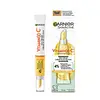What's inside
What's inside
 Key Ingredients
Key Ingredients

 Benefits
Benefits

 Concerns
Concerns

 Ingredients Side-by-side
Ingredients Side-by-side

Water
Skin ConditioningGlycerin
HumectantDimethicone
EmollientPrunus Armeniaca Kernel Oil
MaskingNiacinamide
SmoothingAcrylamide/Sodium Acryloyldimethyltaurate Copolymer
Emulsion StabilisingSilica
AbrasiveCI 77891
Cosmetic ColorantIsohexadecane
EmollientDimethicone/Vinyl Dimethicone Crosspolymer
Skin ConditioningHydroxypropyl Tetrahydropyrantriol
Skin ConditioningCaffeine
Skin ConditioningSynthetic Fluorphlogopite
Propylene Glycol
HumectantPhenoxyethanol
PreservativeAcrylates/C10-30 Alkyl Acrylate Crosspolymer
Emulsion StabilisingTocopherol
AntioxidantChlorphenesin
AntimicrobialPolysorbate 80
EmulsifyingAscorbyl Glucoside
AntioxidantTriethanolamine
BufferingCI 77492
Cosmetic ColorantTrisodium Ethylenediamine Disuccinate
Musa Sapientum Fruit Extract
Skin ConditioningAdenosine
Skin ConditioningHydrolyzed Hyaluronic Acid
HumectantHydroxyethylpiperazine Ethane Sulfonic Acid
BufferingMica
Cosmetic ColorantSorbitan Oleate
EmulsifyingMusa Paradisiaca Fruit Juice
Skin ConditioningAnanas Sativus Fruit Extract
Skin ConditioningCitric Acid
BufferingSodium Benzoate
MaskingDisodium Stearoyl Glutamate
CleansingLactic Acid
BufferingTin Oxide
AbrasivePotassium Sorbate
PreservativeAluminum Hydroxide
EmollientWater, Glycerin, Dimethicone, Prunus Armeniaca Kernel Oil, Niacinamide, Acrylamide/Sodium Acryloyldimethyltaurate Copolymer, Silica, CI 77891, Isohexadecane, Dimethicone/Vinyl Dimethicone Crosspolymer, Hydroxypropyl Tetrahydropyrantriol, Caffeine, Synthetic Fluorphlogopite, Propylene Glycol, Phenoxyethanol, Acrylates/C10-30 Alkyl Acrylate Crosspolymer, Tocopherol, Chlorphenesin, Polysorbate 80, Ascorbyl Glucoside, Triethanolamine, CI 77492, Trisodium Ethylenediamine Disuccinate, Musa Sapientum Fruit Extract, Adenosine, Hydrolyzed Hyaluronic Acid, Hydroxyethylpiperazine Ethane Sulfonic Acid, Mica, Sorbitan Oleate, Musa Paradisiaca Fruit Juice, Ananas Sativus Fruit Extract, Citric Acid, Sodium Benzoate, Disodium Stearoyl Glutamate, Lactic Acid, Tin Oxide, Potassium Sorbate, Aluminum Hydroxide
Water
Skin ConditioningAloe Barbadensis Leaf Juice
Skin ConditioningSimmondsia Chinensis Seed Oil
EmollientCaprylic/Capric Triglyceride
MaskingCandelilla/Jojoba/Rice Bran Polyglyceryl-3 Esters
EmulsifyingMangifera Indica Seed Butter
Skin ConditioningGlycerin
HumectantMagnesium Aluminum Silicate
AbsorbentCetearyl Alcohol
EmollientGlyceryl Stearate
EmollientCaffeine
Skin ConditioningOenothera Biennis Oil
EmollientC15-19 Alkane
SolventAcetyl Hexapeptide-8
HumectantRosa Canina Fruit Oil
EmollientMalpighia Glabra Fruit Extract
Skin ConditioningPhyllanthus Emblica Extract
Skin ConditioningEuterpe Oleracea Fruit Extract
Cocos Nucifera Oil
MaskingOryza Sativa Extract
AbsorbentSuperoxide Dismutase
AntioxidantSoybean Peroxidase
AntioxidantMaltodextrin
AbsorbentLactobacillus Ferment
Skin ConditioningLeuconostoc/Radish Root Ferment Filtrate
AntimicrobialLeuconostoc Ferment Filtrate
AntimicrobialXanthan Gum
EmulsifyingEthylhexylglycerin
Skin ConditioningIsoamyl Cocoate
Sodium Stearoyl Lactylate
EmulsifyingIsoamyl Laurate
EmollientCitric Acid
BufferingPhenoxyethanol
PreservativeWater, Aloe Barbadensis Leaf Juice, Simmondsia Chinensis Seed Oil, Caprylic/Capric Triglyceride, Candelilla/Jojoba/Rice Bran Polyglyceryl-3 Esters, Mangifera Indica Seed Butter, Glycerin, Magnesium Aluminum Silicate, Cetearyl Alcohol, Glyceryl Stearate, Caffeine, Oenothera Biennis Oil, C15-19 Alkane, Acetyl Hexapeptide-8, Rosa Canina Fruit Oil, Malpighia Glabra Fruit Extract, Phyllanthus Emblica Extract, Euterpe Oleracea Fruit Extract, Cocos Nucifera Oil, Oryza Sativa Extract, Superoxide Dismutase, Soybean Peroxidase, Maltodextrin, Lactobacillus Ferment, Leuconostoc/Radish Root Ferment Filtrate, Leuconostoc Ferment Filtrate, Xanthan Gum, Ethylhexylglycerin, Isoamyl Cocoate, Sodium Stearoyl Lactylate, Isoamyl Laurate, Citric Acid, Phenoxyethanol
 Reviews
Reviews

Ingredients Explained
These ingredients are found in both products.
Ingredients higher up in an ingredient list are typically present in a larger amount.
Caffeine is most associated with coffee, tea, and cacao. In skincare, it helps with calming inflammation and is rich in antioxidants.
While caffeine is used to treat cellulite and and dark circles, further studies are needed to prove this. It has been believed to help with these skin conditions due to its ability to dilate blood vessels and increase blood flow.
Some studies are looking into caffeine's ability to protect against UV rays.
Learn more about CaffeineCitric Acid is an alpha hydroxy acid (AHA) naturally found in citrus fruits like oranges, lemons, and limes.
Like other AHAs, citric acid can exfoliate skin by breaking down the bonds that hold dead skin cells together. This helps reveal smoother and brighter skin underneath.
However, this exfoliating effect only happens at high concentrations (20%) which can be hard to find in cosmetic products.
Due to this, citric acid is usually included in small amounts as a pH adjuster. This helps keep products slightly more acidic and compatible with skin's natural pH.
In skincare formulas, citric acid can:
While it can provide some skin benefits, research shows lactic acid and glycolic acid are generally more effective and less irritating exfoliants.
Most citric acid used in skincare today is made by fermenting sugars (usually from molasses). This synthetic version is identical to the natural citrus form but easier to stabilize and use in formulations.
Read more about some other popular AHA's here:
Learn more about Citric AcidGlycerin is already naturally found in your skin. It helps moisturize and protect your skin.
A study from 2016 found glycerin to be more effective as a humectant than AHAs and hyaluronic acid.
As a humectant, it helps the skin stay hydrated by pulling moisture to your skin. The low molecular weight of glycerin allows it to pull moisture into the deeper layers of your skin.
Hydrated skin improves your skin barrier; Your skin barrier helps protect against irritants and bacteria.
Glycerin has also been found to have antimicrobial and antiviral properties. Due to these properties, glycerin is often used in wound and burn treatments.
In cosmetics, glycerin is usually derived from plants such as soybean or palm. However, it can also be sourced from animals, such as tallow or animal fat.
This ingredient is organic, colorless, odorless, and non-toxic.
Glycerin is the name for this ingredient in American English. British English uses Glycerol/Glycerine.
Learn more about GlycerinPhenoxyethanol is a preservative that has germicide, antimicrobial, and aromatic properties. Studies show that phenoxyethanol can prevent microbial growth. By itself, it has a scent that is similar to that of a rose.
It's often used in formulations along with Caprylyl Glycol to preserve the shelf life of products.
Water. It's the most common cosmetic ingredient of all. You'll usually see it at the top of ingredient lists, meaning that it makes up the largest part of the product.
So why is it so popular? Water most often acts as a solvent - this means that it helps dissolve other ingredients into the formulation.
You'll also recognize water as that liquid we all need to stay alive. If you see this, drink a glass of water. Stay hydrated!
Learn more about Water